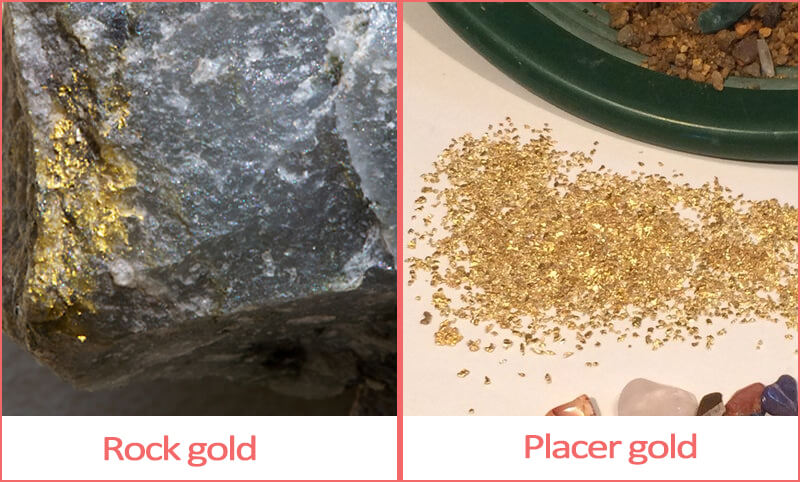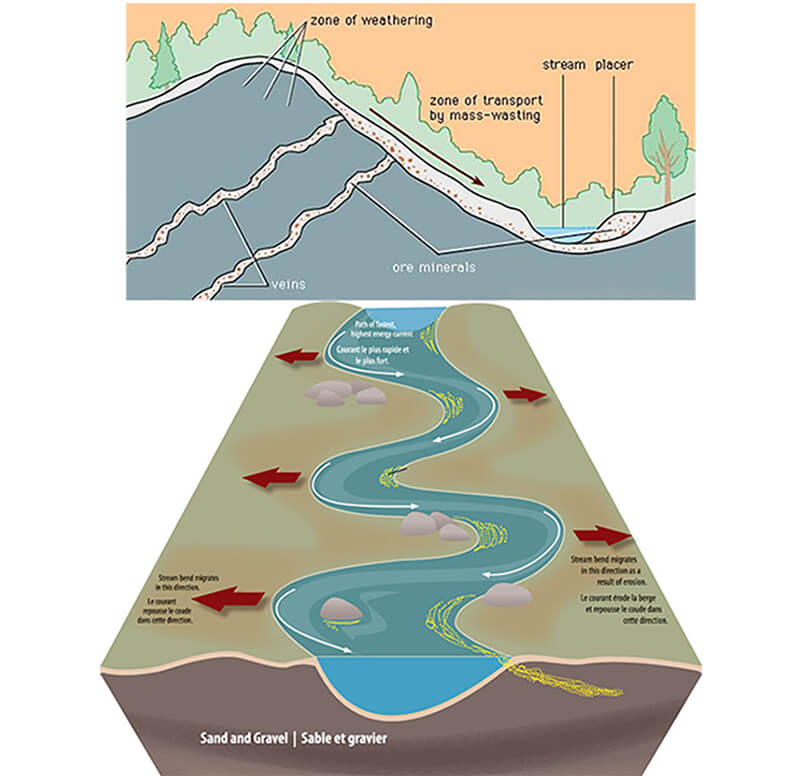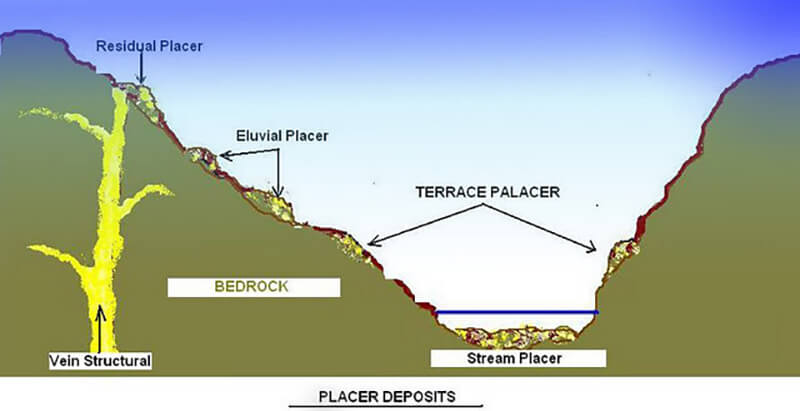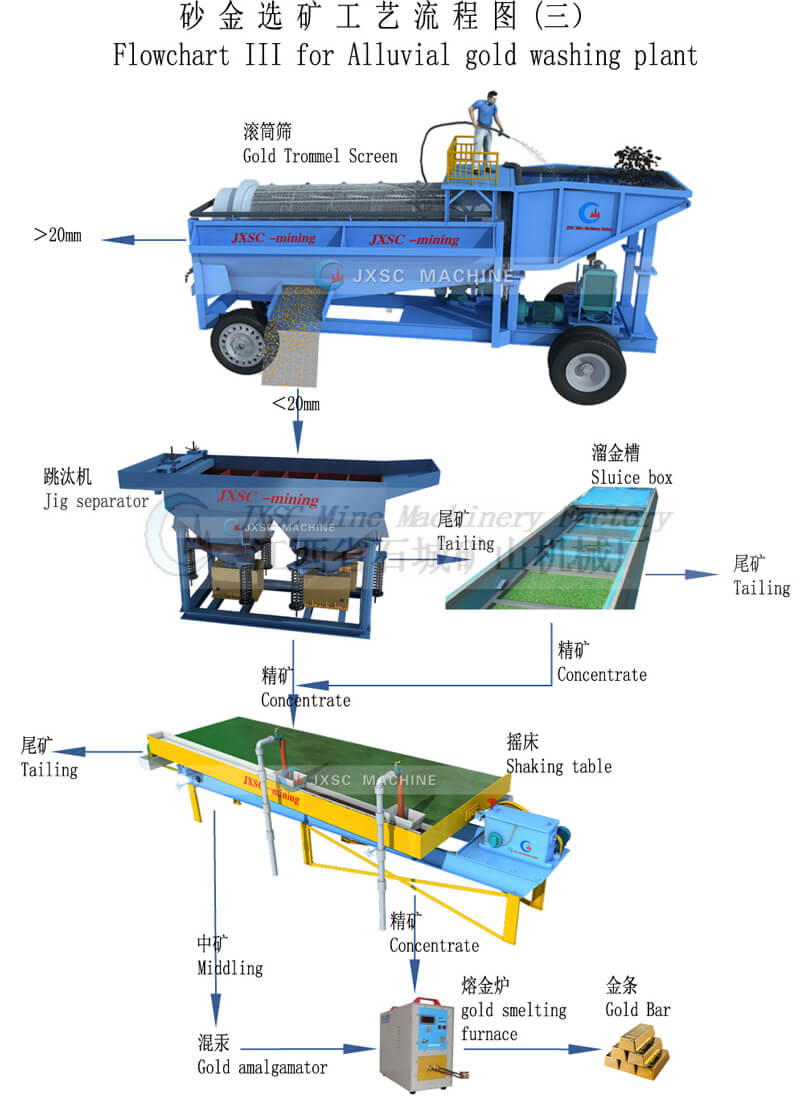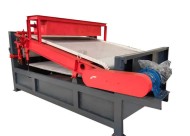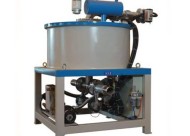Alluvial gold is formed by gravity separation from a specific gold containing rock during the sedimentary process. Thereby, this kind of placer deposit is usually as fine as sand, also called sand gold.
Placer deposit is a significant source of gold, placer mining was the main method used in the early years of many gold rushes, like the California gold rush.
Next, I will do a description of the following aspects:
Go to the What is the placer gold, Types of placer deposit, Placer gold mining flowsheet and equipment.
What is the placer gold
According to mineral morphology, the gold mineral is divided into rock gold and placer gold.
1. Rock gold is the most common form of pure gold. Gold is hidden in the quartz veins in the rock, we need to find the gold-bearing rocks first, then exploit the ore, crush them into ore powder, and then purify them by gravity or flotation.
2. The placer gold is easy to mine. The process of rock gold mining is relatively complicated and difficult. Generally, a ton of ore is mined to extract a few grams of gold.
The presence of the primary gold-bearing geological body is a prerequisite for the formation of placer gold deposits. These primary gold-bearing geological bodies can be either primary gold ore bodies, gold-bearing altered rock belts, fractured fracture zones, or wide area gold-bearing rock masses rock formations.
A hilly area is a place where gold is concentrated. In the same area, where the gold placer is concentrated where the relative height difference changes from large to small. The gold particles are transported and moved by various natural forces and will be deposited in a favorable geological environment.
The riverbed alluvial deposit is the most important source of gold deposits in gold production. Alluvial deposits are formed by a series of deposition processes. The deposition is a dynamic process, due to the lateral movement of the river channel, the location of the river alluvial gold deposit in the valley is generally not consistent with the current river channel, often occur on the side of a moving curved channel or downstream of a river.
The confluence of rivers or streams plays an important role in the search for gold deposits, the eddies generated at the confluence enhance the deposition of gold particles.
The distribution of placer gold in the gravel layer is extremely uneven. After a long period of hydraulic erosion, the lighter gold particle is carried away by the flowing water, while the coarse gold with a larger specific gravity and smaller grain size falls into the lower or bottom of the gravel layer along with the pores between the sand particles. In general, gold is enriched in the lower part of the gravel layer, that is, placer gold enriches in the gravel layer about 1 to 2 meters above the bedrock, even enriched on the bottom of the gravel layer.
Types of placer deposit
According to the landform and formation conditions, placer gold can be divided into
- River gold deposit, in the river bed, bank, or shoal
- Flood plain gold deposit, mostly large and medium-sized deposits.
- Terrace gold deposit, in the valley slope terrace area, most of them are the remaining parts of the original floodplain gold deposits that were eroded.
- Valley gold deposit usually in coarse size, with high grade and low water content, it is a good source of gold production, but a shortage in small scale.
- Karst gold deposit often produced in karst tunnels and caves.
The width of gold deposits is generally 50-300m or wider, and the length can reach several kilometers or even tens of kilometers; generally it is made up of soft sandstone; the buried depth of the ore is generally 1-5m, some would 20-30m even deeper; the thickness of the gold-bearing ore layer is usually 1-5m; the bottom of gold layer is mostly granite, shale, limestone.
Associated minerals
In addition to gold, gold deposits also contain a variety of heavy minerals, which associated with gold, magnetite, ilmenite, rutile, garnet, zircon, hematite, chromite, olivine, epidote, pyrite, monazite, limonite, platinum, antimony, cinnabar, wolframite, scheelite, cassiterite, corundum, diamond, mercury paste, galena, etc.
In the placer gold deposit, heavy minerals usually does not exceed 1-3 kg/m3, and the rest are gravel, pebbles, sand and clay. Clay is not good for the fine-grained gold recovery process and should be removed before the gold selection process.
Gold is mostly in the form of granules, flakes and branches in the placer gold deposits, its size generally in the range of 0.2-2mm.
Characteristics of placer gold
1 Low gold content, generally 0.2-0.3g/m3, and the content of heavy mineral (S>4) is usually 1-3kg/cm3.
2 The maximum particle size of gangue ore is often several thousand times larger than the minimum grain size of placer gold. That is to say, raw ore of sand gold is in large size, it is necessary to pick out the gold-free gravel and reduce the size of the ore containing ore.
3 Low production rate
4 High concentration ratio
5 It takes several complicated beneficiation processes to obtain gold and qualified heavy mineral concentrates.
According to the particle size
gold is divided into
1. Large grain gold (greater than 5 mm)
2. Coarse grain gold (1.65 ~ 5 mm)
3. Medium grain gold – 0.83 ~ 1.65 mm
4. fine grain gold – 0.42 ~ 0.83 mm
5. Particulate gold – 0.15 ~ 0.42 mm
6. Floating gold – less than 0.15 mm.
![Placer gold mining flowsheet and equipment]()
Placer gold mining flowsheet and equipment
The beneficiation of placer gold ore is based on the difference in physical properties of minerals, such as the difference in particle size, shape and specific gravity, the gravity separation is the main method of placer alluvial gold beneficiation processing.
Commonly used gravity separation equipment includes chute (sluice), various types of mineral jigs, gold shakers, centrifugal concentrators, etc. Cross-flow belt chutes, short cone hydrocyclones, vibrating chutes, etc., have broad application prospects.
According to the working principles, the gravity separation process can be divided into ore washing, particle grading, gold sluice, gold jig, gold shaker and heavy medium separation. Among them, except for washing and grading, which are mainly separated by particle size, the other is the process of separating the minerals by specific gravity (density).
1.Preparation before beneficiation
The preparation work before the selection mainly includes the disintegration, classification, cleaning and de-sludge of the sand mine.
Disintegration: break the sand mud lump to monomer particle, separate the valuable minerals.
Classification: Separate coarse gravel that does not contain gold and other heavy minerals.
Disintegration and classification operations can be carried out in one equipment as a gold trommel scrubber or a trommel screen, can also be used for washing and deliming.
2.Heavy mineral separation
Remove light minerals and stone remaining in the slurry, then separate other heavy minerals to obtain gold.
Generally, use large size fixed gold sluice to select the coarse gold, and then use gold pan to select the gold concentrate.
In order to improve the gold recovery rate, the roughing operation can also use a gold jig to replace the sluice, and replace the gold pan with a jig and a shaker.
3. Concentration
The commonly used beneficiation equipment are shaker table, jig, mercury amalgamation cylinder, magnetic separator, electric separator, and the like. After these treatments, the gold department was concentrated in the mercury paste.
The typical process of river alluvial gold mining.
JXSC, 35 YEARS of mining equipment manufacturing, learn how we maximize your profits by efficiency, safety, min.maintenance.
Related post:
5 Easily Extracted Gold Ores and 8 Processing Methods
Hard rock gold mining
LATEST PRODUCTS
Heavy Plate Feeder
Capacity: 100-240 m3/h Power: 15-45 kW Speed: 0…
Plate Magnetic Separator
【Capacity】8-35 t/h 【Power】1.5-3 kW 【Applic…
Slurry Magnetic Separator
【Capacity】10-100 m3/h 【Feeding Material Densi…






